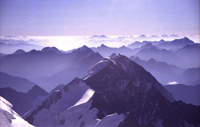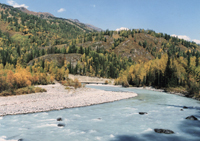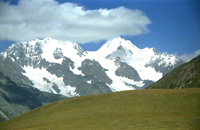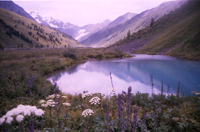 |
 |
Altai |
|
|
 |
 General Information General Information
Since the times of Herodotus, people have been aware of a wild mountainous country deep in the continent, with a short and resonant name - Altai. Rising into the skies, Altai is a vast place to the south of the Siberian taiga with scary impenetrability and numerous swamps and rivers. From the south, this mountainous land is girded by sun-scorched deserts of Central Asia and Kazakhstan, with dry winds blowing from Central Asia. Altai, with its wing-like branches, connects and divides Siberia and the heart of Central Asia. The great mountain knot is the source of almost all бranges of Altai. It is a famous part of the world divide between in the inland drainage basin of Central Asia and the waters of the Arctic Ocean.

The highest and most beautiful double peak in Altai is Belukha (Muztau), on the border between Kazakhstan and Russia.
The mountainous country of Altai is located in latitude between 48 and 53 North, and its southwestern part bulges out into our country as the Kazakhstani Altai.The Kazakhstani Altai occupies almost one tenth of the country. It is a strikingly beautiful land with wonderful natural contrasts. It includes almost all landscape and zonal conditions: desertified peripheral rocky mountains going out to the Zaisan Depression, rocky ridges capped with permanent snow and snowfields, usually hidden underneath a sheet of clouds.
The western part of the Kazakhstani Altai, or Rudnyi Altai, is a world-known depository of ore minerals. This is why the mountains were called the Altai, which means “gold mountains”. The ridges of the Kazakhstani Altai have a complex geological structure: its western peripheral part features gentle rolling plains which in the east turn into medium-high mountains with broad valleys and deep and narrow gorges in the mountainous parts. In some places, the mountains and plains of Altai are overshadowed by groups of dented rocky ridges, ranges and peaks which are sources of modern glaciation.
The climate of Altai is strongly continental, with a big amplitude of daily, seasonal and average annual fluctuations of the air temperature, which owes to the intracontinental location of this mountainous land. Altai is the meeting spot for the strongly continental Mongolian climate, the steppe and semi-desert climate of Central Asia, and the continental climate of Western Siberia .
The coldest months are January and February, with a monthly average temperature of -17°Сto -23.8°Сin the northern Rudnyi Altai and high-altitude basins, and -14.1°Сto -16.6 °Сin the southern part. July is the warmest month, with the monthly average temperature of + 14°Сto + 16°С, and about zero at 1,000 to 1,500 m above sea level. The temperature is a bit higher in the foothills and on the plains.
Glaciers are the feeding source for Altai’s water bodies. In Altai, the glaciers usually go down to 2,600 m above sea level. The severe highland climate affects the adjacent area, too. The total area of the permafrost in Altai is estimated to be 5,670 km2, and its lowest line is at 2,000 m .
As an irriguous high-mountain area, Altai features a dense drainage network. The most profluent stream in Kazakhstan is the Irtysh River , with a total length of 4,248 km (of which 1,400 km flow within Kazakhstan ). It starts in western slopes of the Mongolian Altai at 2,500 m and is called the Kara Yertis (Black Irtysh) there. The Black Irtysh flows in Lake Zaisan and goes out as the Irtysh River . Currently, the lake has been dammed with the Bukhtarma Reservoir. Lake Maloye Irtyshskoye (over 70 km long) and the Ust-Kamenogorsk hydroelectric power station are situated below. The Irtysh is 120to 150 m wide.
 Kalba Kalba
The Kalbinskiy Range is at 1,608 m above sea level to the south-west of Rudnyi Altai, on the left bank of the Irtysh, and is a westward continuation of the southern Altai mountains . The western edge of Kalba merges into the Kazakhstani fold area. On average, the mountains of Kalba are not higher than 1,000 m above sea level. From the north, or the Irtysh side, the mountains have unusual shapes and rise as exotic sharp-edged castles in close groups. The north-western part of the range strikes with steep and peaked mountain groups covered with granite tilted plates: Monastyri ( 816 m above sea level) and Airtau ( 1003 m above sea level), rising up amongst a hilly steppe. The high Mount Dungaly is beautiful ( 749 m above sea level), looking like a giant pyramid, with Lake Dubygalinskoye washing its northern part. The unique Sebinskaya group near Koktau Massif is the largest one, and is a fancy tangle of rocks girded by five shallow lakes. Kalba is the land of fabulously magnificent lakes. Most of them are in the north-western part among short branches at 580- 620 m above sea level. All lakes are of tectonic origin and shallow. They are girded by granite and sandstone rocks and tabular boulders, with clear fresh flowing water. Their shores are vegetated with fescue, wormwood, reed, aspen, birch trees, brier, Siberian pea shrub, and chokecherry. Some lakes have waterlogged coastlines, and there are green shrubs of pondweed and lilies. The lakes are rich in roach, pike, dace, gudgeon, tench, and carp.
 Southern Altai Southern Altai
As a mountainous system, Altai is characterized by vast plateaus. The alpine plateau of Ukik (2,300 to 2,500 m above sea level) with numerous ridges is called the heart of Altai. Not far from the Kanas Pass , the eastern border of Kazakhstan crosses the plateau in the western part. At the upper reaches of the Belaya Berel, it goes out to the Katun Alps and goes near Mount Muztau (Belukha) – the highest double peak in Altai ( 4,620 m above sea level), covered with snow and glaciers. To the south of the Ukok tableland and the Bukhtarma Valley , there is a system of mountain ranges – Southern Altai . The wooded and steep Southern Altai range at 2,300 to 3,400 m above sea level has sharp variations from the steppe vegetation (abundant on southern slopes) to woods.
At 1,495 m above sea level, between Sarytau and Azutau ranges, there is a most beautiful alpine lake of Altai – Markakol. It occupies a deep tectonic excavation in branches of the Kurchum Range and is located at 1,485 m above sea level. It is the largest lake in Altai, with 27 big and small creeks and rivers flowing into it, and only one (Kaldzhir) flowing out. The lake is 27 m deep, and 6 to 7 m transparent. It has the Markakol State Reserve.
The 364-km-long Bukhtarma, a tributary of the Irtysh , is one of the biggest rivers in Altai. Wood is rafted along this ancient river, and water tourists enjoy having time here. The other big river in Southern Altai is the 100-km-long Narym, which flows into the Bukhtarma Reservoir. The Narym is a significant irrigation river.
LakeMaralye (Chaban-Bai) is on the southern slope of the Listvyaga Range . The Belaya River goes out of it to flow in the Bukhtarma. Lake Yazovoye (Kara-Kul) is in the wooded area. Lake Rakhmanovskoye is strikingly beautiful. It is located amongst steep wooded slopes at 1,760 m above sea level. It has thermal water outlets with a temperature of + 22 to 3°С. It ssanative properties are close to the water of Tskhaltubo and Belpkurikha. A small river of Arasan ( 2.6 km long,about 600 m wide, 30 m deep) flows in the lake. The color of all these lakes is variable depending on the weather. The lead-grey tint of the water caused by clouds changes into bright ultramarine colors when the sun goes out.
The forest belt of Southern Altai is in the upper limits, 2,300 to 2,400 m above sea level. The Siberian larch is the main species here. Common cedar and larch forests with the Siberian fir, common spruce and broad-leaved trees (birch, aspen and poplar) are very beautiful.
The wildlife of Southern Altai is rich and versatile. A lot of rare and extinct species live here. For example, Lake Markakol has endemic forms of lenok, grayling and gudgeon. A striped racer was once caught at the foothills of the southern part of the Kurchum Range – a snake whose habitat is in Manchuria and Korea. There are 250 species of birds here, many of which are ecologically linked with either inland water bodies or dry rocky mountains e.g., white-tailed eagle and osprey – big fish-eating birds of prey. The black stork is common here, too. The Markakol Reserve has the great black-headed gull – the biggest gull ever, as well as goldeneye, red-breasted merganser and tufted duck. Dry slopes are inhabited by chuckors, hill pigeons, rock swallows, and Mongolian finches. The Altai snowcock, listed in the Red Book, inhabits the uplands. There are a lot of mammals here. For example, Southern Altai is abundant in Siberian deer (numerous enough to hunt). The Kuchum, Southern Altai, Tarbagatai and Narym ranges are inhabited by at least ten snow leopards. The red dog is rarely seen. Cliffs are inhabited by the Alpine ibex, and gorges, by the tek (a mountain goat). The argali live on the steppe slopes. The taiga and the alpine belt have groups of rock outbreaks the home of the smallest tusky deer – the musk deer. Its population grows every year. Sometimes, the wild boar and moose visit the southern mountains from the Zaisan Depression.
Western Altai – a region rich in mineral resources and famous beyond Kazakhstan . This part of Altai is rightfully called Rudnyi (ore-rich). Western Altai is located between the Uboi (north-east) and the Bukhtarma (south-east) rivers. The south-western border goes along the Irtysh which separates Kalba from Western Altai . The central part of Western Altai has one of the most beautiful and highest ranges – the Ivanovskiy, the eastern part of which splits into a number of high snowfields: Prokhodnoi ( 1,864 m above sea level), Serzhinskiy ( 2,012 m above sea level), Rassypnoi ( 2,317 m above sea level), and Ivanovskiy proper. Mount Krestovaya ( 2,200 m above sea level) is on the right bank of the Gromotukha River . To the east of this peak, there are dark jagged peaks of the Three Brothers ( 2,397 m above sea level). Farther to the east (in the middle of the snowfield), the Vysheivanovskiy Peak reaches up to the sky – the highest mountain in Western Altai – 2,877 m above sea level. To the south of Ivanovskiy, there is the Ulbinskiy range with Verkhne-Ulbinskaya being its highest peak ( 2,368 m above sea level). It is scattered with rocks, whited with snowfields and crowned with rocky buttes. The medium-high mountains have a most picturesque Malo-Ulbinskoye Reservoir. Merging in the east, the two ranges form the Chernyi Knot ( 2,600 m above sea level) – a forbidding group of peaks with precipitous bluffs. A few corrie lakes, commonly known as Turgusunskiye, are at the foot of the bluffs.
The flora of Western Altai is rich and versatile: over 1,000 species. Western peripheral branches are covered with steppe vegetation. In the spring and summer, the mountains are covered with red and crimson colors of blooming peonies, the blue of ixilirions and pasque flower, the bright yellow of the Altai leontissa, Siberian chorispora, and Altai tulips.
|
 |
|
 |
 |
|
|
|
|
 |
|
